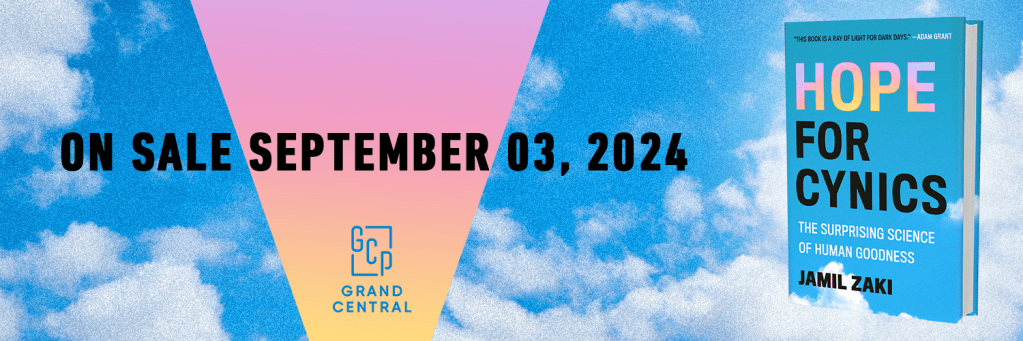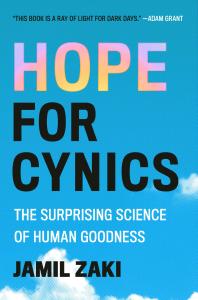HOPE FOR CYNICS Max Shelf

READ AN EXCERPT
I was always jealous of Emile Bruneau. We were both professors of psychology. We both used brain science to study human connection, and hoped our work could help people connect more effectively. We presented at many of the same conferences and snuck out for martinis at many hotel bars, becoming fast friends along the way.
Emile probably made a lot of people jealous. A square-jawed ex–rugby player, he turned heads anywhere he went, which was everywhere he could. Emile worked to promote peace in Northern Ireland, biked across South Africa, and grappled with a local wrestling champion in Mongolia. At home, he assembled a Ford Model A, tended bees, and built his kids a tree house more elaborate than some New York City apartments. His professional accomplishments were just as impressive: Emile founded the Peace and Conflict Neuroscience Lab at the University of Pennsylvania, which pioneered scientific tools for overcoming hatred.
Emile was larger than life, but the thing I most envied about him was his hope. This might seem strange given what I do for a living. For two decades, I’ve studied kindness and empathy, teaching people around the world about the importance of these virtues. This has made me an unofficial ambassador for humanity’s better angels, often recruited to jump- start people’s faith in one another.
But all this time, I’ve lived with a secret. In private, I’m a cynic, prone to seeing the worst in people. This tendency began early; a chaotic family life made it hard for me to trust people’s intentions. Since then, I’ve found stronger emotional footing through new relationships and been uplifted by science as well. My lab and I have discovered that most people value compassion over selfishness, that donating money activates similar parts of your brain as eating chocolate, and that helping others through their stress soothes our own. The message of our work is simple: There is good in us, and it does good for us.
But there’s a difference between understanding something and feeling it. I’ve met miserable happiness experts and stressed- out meditation researchers. Scientists are sometimes drawn to what they have trouble finding in their own lives. Perhaps I’ve spent all this time charting a map of human goodness in the hopes of locating it more easily on the ground.
Recently, finding the good in others has become harder instead. Emile and I met in 2010. In the decade that followed, division, inequality, depression, and sea levels all rose. In my own social circle, I witnessed industrious, brilliant friends struggle to find work, let alone any semblance of the American dream. I joined Twitter to follow other scientists but encountered a deluge of outrage, lies, and personal branding. California caught fire, and the hilly vineyard where my wife and I had eloped was consumed. On our anniversary, we drove through its charred remains, wondering how much more of the world would look like this, how soon. I could recite evidence about kindness from my lab and a dozen others, but as the world seemed to grow greedier and more hostile, my instincts refused to follow the science.
Emile was one of the few people with whom I shared this struggle. Across many conversations, he tried to resuscitate my hope. Our science could teach people about the good inside them, he’d say, and about the fears that keep that good covered, like the sun behind clouds. We could move people toward community and justice—their true values.
Emile’s plucky monologues seemed ridiculous, and sometimes made me wonder if we had that much in common after all. He had witnessed hatred on five continents. Where did he get off being so optimistic? His positivity seemed like wishful thinking, or the sign of a sheltered mind.
Then one day we talked about his childhood, and it became clear how wrong I’d been. Shortly after Emile was born, his mother was plagued by cruel, mocking voices, as inescapable to her as they were imperceptible to everyone else. She had developed severe schizophrenia and for the rest of her life she remained at war with her own mind, unable to raise Emile.
Yet when they were together, she protected him from the mayhem inside her. “She never let any of the darkness touch me,” he remembered. “Even when she was in the pits of despair, she only gave me light.” Hearing him recount this story, I realized Emile was the opposite of naive. He had seen firsthand how care could bloom in the face of immense pain. In fighting for our best side, he didn’t have the luxury of seeing only our worst. His hope was like his mother’s tenderness: a defiant choice.
In 2018, that hope would be tested again. His laptop screen looked dimmer each night; then the headaches began. As a neuroscientist, he recognized the warning signs, requested a CT scan, and discovered the brain cancer that would take his life two years later, at the age of forty- seven. The tragedy hit him and his family squarely. Emile’s children, four and six years old, would grow up without their father. His wife, Stephanie, would lose her beloved partner. Decades of work would go undone, the world deprived of Emile’s insight.
But something else happened inside him. Emile wrote to me that he was filled with “an awareness of all that is beautiful in the world.” We all die, he said, but most of us don’t know how much time we have. He was determined to fill his remaining days with community and purpose. Fresh out of surgery to remove a tumor from his brain, Emile convened a group of researchers at his home and issued a challenge. “Our goal should be more dramatic than just doing good science,” he urged. Like Emile, they could go to war-torn places, speak with suffering people, and put science to work for peace. “We can walk through darkness and spread light.”
Emile died on September 30, 2020. Many mourned an inspiring father, scientist, and friend. I also mourned his worldview. Emile believed hope is like light guiding our paths. If that was true, the world seemed to be dimming as the COVID pandemic lumbered on. Like the last, lingering moments of dusk, it was growing harder to see anything in front of us.
That year, the fault line separating my rosy persona and gloomy inner life widened into a canyon. Schools, hospitals, and companies invited me to speak about my work and help them feel hope, but mine was gone. On Zoom from my living room, I celebrated human kindness to people around the world. As soon as the screen went black, I returned to doomscrolling.
But my job is to be curious about the human mind, and after a while, I began to examine my own cynicism. It’s a seductive worldview, dark and simple. Too simple, really, to explain much of anything. Cynicism encouraged me to expect the worst from people, but what gave me the right? It told me the future would be awful, but how could anyone know that? What was cynicism doing to me? To all of us? As I soon learned, it wears away the psychological glue that binds us. Trust, the willingness to be vulnerable to others, is an expression of faith that they will do the right thing. It is how hope lives between people. By eroding trust, cynicism steals our present together and dampens the futures we can imagine.
I thought often about Emile. How had he retained astonishing positivity even as his life was cut short? Can the rest of us do the same during our own dark times? These questions led me on a scientific journey that changed my mind, and a personal journey that changed my life. Exploring decades of research, I discovered that cynicism is not just harmful, but often naive. Hope and trust, by contrast, are wiser than most people realize. They are also skills we can build through habits of mind and action. I wish I’d known those practices earlier, but I am grateful for them now and believe they are worth sharing.
This book is about why so many people feel the way I used to, and how anyone can learn to think more like Emile.
Cynicism is making us sick; Stanford Psychologist Dr. Jamil Zaki has the cure—a “ray of light for dark days” (Adam Grant, #1 New York Times bestselling author).
For thousands of years, people have argued about whether humanity is selfish or generous, cruel or kind. But recently, our answers have changed. In 1972, half of Americans agreed that most people can be trusted; by 2018, only a third did. Different generations, genders, religions, and political parties can’t seem to agree on anything, except that they all think human virtue is evaporating.Cynicism is a perfectly understandable response to a world full of injustice and inequality. But in many cases, it is misplaced. Dozens of studies find that people fail to realize how kind, generous, and open-minded others really are. Cynical thinking worsens social problems, because our beliefs don’t just interpret the world—they change it. When we expect the worst in people, we often bring it out of them.
Cynicism is a disease, with a history, symptoms—and a cure. Through science and storytelling, Jamil Zaki imparts the secret for beating back cynicism: hopeful skepticism. This approach doesn’t mean putting our faith in every politician or influencer. It means thinking critically about people and our problems, while simultaneously acknowledging and encouraging our strengths. Far from being naïve, hopeful skepticism is a more precise way of understanding others, and paying closer attention re-balances how you think about human nature. As more of us do this, we can take steps towards building the world we truly want.
